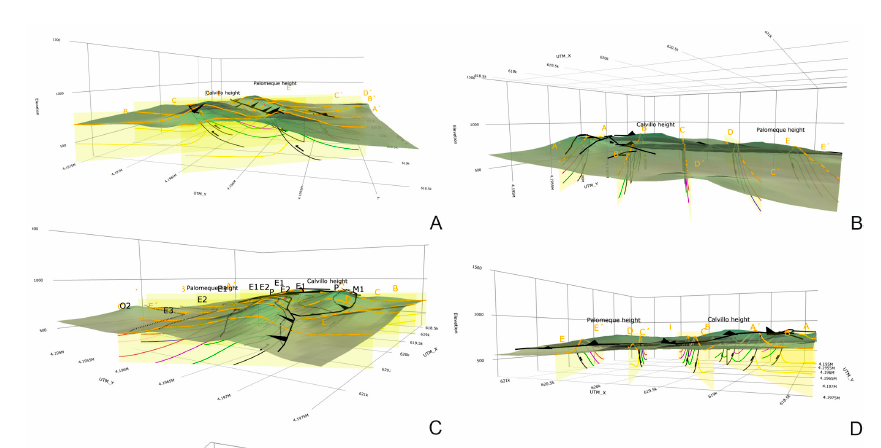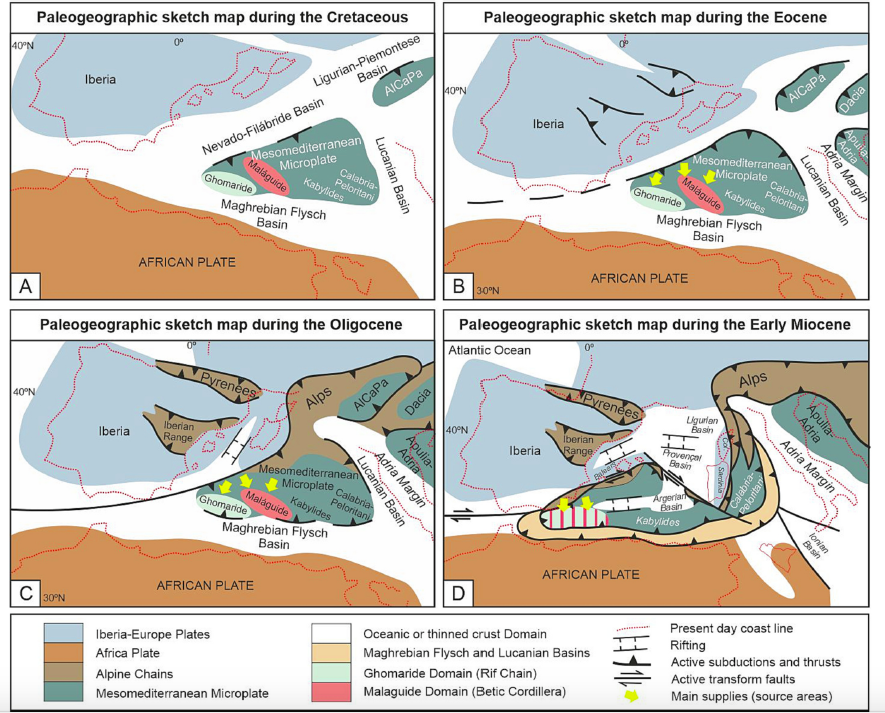A Python Application for Visualizing an Imbricate Thrust System: Palomeque Duplex (SE, Spain)
This paper introduces a Python application for visualizing an imbricate thrust system. The application uses the traditional geologic information to create an HTML geological map with real topography and a set of geological cross-sections with the essential structural and stratigraphic elements. On the basis of the high geological knowledge gained during the last three decades, the Palomeque sheets affecting the Cenozoic Malaguide succession in the Internal Betic Zone (SE Spain) were selected to show the application. In this area, a Malaguide Cretaceous to Lower Miocene succession is deformed as an imbricate thrust system, with two thrusts forming a duplex, affected later by a set of faults with a main strike-slip kinematic. The modeled elements match well with the design of the stratigraphic intervals and the structures reported in recent scientific publications. This proves the good performance of this Python application for visualizing the structural and stratigraphic architecture. This kind of application could be a crucial stage for future groundwater, mining, and civil engineering management.

Cite as: Bullejos, M., Martín-Martín, M., 2023. A Python Application for Visualizing an Imbricate Thrust System: Palomeque Duplex (SE, Spain). Geosciences. https://doi.org/10.3390/geosciences13070207
Supplementary Materials: The following supporting information can be downloaded at: https://www. mdpi.com/article/10.3390/geosciences13070207/s1: interactive 3D geological map: 3D_Palomeque_map_sections.html; interactive 3D geological sections: 3D_Palomeque_map_sections.html. Python codes and the detailed instructions to download and run the codes can be found in a GitHub repository at: https://github.com/bullejos/visualizing-an-imbricate-thrust-system.
Cenozoic detrital suites from the Internal Betic-Rif Cordilleras (S Spain and N Morocco): implications for paleogeography and paleotectonics
A synthesis of Cenozoic detrital suites from the Internal Betic-Rif Cordilleras is discussed in relations with major paleotectonic phases during growth of orogenic belts. The discussion has been focused on the Malaguide and Ghomaride complexes that have a Cenozoic sedimentary detritic cover. The heterogeneous petrographic composition of coarse detrital rocks, and the mineralogy and geochemistry of mudrocks indicate a multiple source area consisting in metamorphic, and recycled siliciclastic and carbonate source rocks, with a minor supply of mafic rocks during the early Miocene. The siliciclastic coarse detrital suites plot mainly in a wide area at the Qm-Lt side in a Qm-F-Lt diagram reflecting their transition between a craton, quartzose recycled, quartzose transitional orogenic, and finally lithic transitional orogenic provenance type. The Paleocene-Eocene successions seem to be affected by higher weathering effects than the Oligo-Miocene ones. Significant recycling and reworking processes should take place during the Paleocene-Eocene and the Oligo-Miocene before the final deposition. The source areas were characterized by non-steady-state weathering conditions reflecting a progressive cooling contemporaneous to the typical evolution of source areas where active tectonism allows erosion within weathering profiles developed on source rocks. A sharp increase of siliciclastic content together with the changes in sorting-recycling-weathering suggests abrupt changes in the source area starting from Oligocene. This fact allows subdividing the succession into the lower (Paleocene-Eocene) and the upper (Oligocene-Early Miocene) cycles. Lower cycle was contemporaneous to the Eo-Alpine tectonic phase, which was reflected in the Malaguide and Ghomaride domains by basement folding and deep tectonics with fault-propagation folds, accomplished by minor rising or reliefs and deepening of subsidence areas. Contrarily, the upper cycle took place during the Neo-Alpine phase, when in the Malaguide and Ghomaride domains, thrustings should become superficial contemporaneous to subduction and stacking of tectonic units.

This led to a strong increasing of rising areas reflected in the sedimentation by the occurrence of coarse terrigenous deposits in wedge-top basins. The early Miocene also shows the influence of volcanism in the Mediterranean region, and/or the erosion of magmatic-metamorphic rocks derived from deep tectonic levels affected in the Eo-Alpine phase or belonging to the Hercynian bedrock. This evolution fits well with recent paleogeographic-geodynamic models for the western-central Mediterranean.
Cite as: Martín-Martín, M., Perri, F., Critelli, S., 2023. Cenozoic detrital suites from the Internal Betic-Rif Cordilleras (S Spain and N Morocco): implications for paleogeography and paleotectonics. Earth-Science Rev. 243, 104498. https://doi.org/10.1016/j.earscirev.2023.104498
Recent Comments